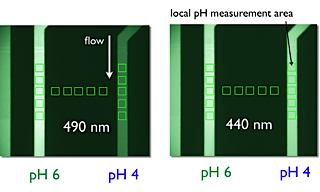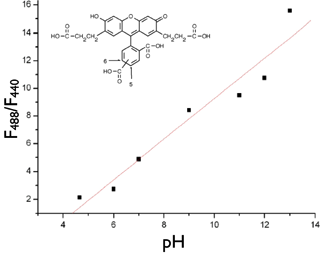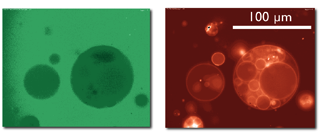Dual excitation dyes e.g. the fluorescein derivative 2',7'-bis-(2-carboxyethyl)-5-(and-6)-carboxyfluorescein (BCECF) emit at a single set of wavelengths, but the sensitivity of that wavelength to pH depends upon the excitation wavelength. Typically excitation with one set of wavelength yields a signal that rises with alkalinization whilst excitation with another set of wavelengths causes the opposite change in fluorescence. Thus by dividing the emission at one wavelength by the other one can derive a measure of pH. The ratio has the property of being independent of dye concentration.

We developed a method to detect pH in continuous flow microfluidic systems using our confocal laser-scanning microscopy setup and BCECF as pH-sensitive dye. The upper figures show the fluorescence images of different buffer solutions flowing through microfluidic channels.

The fluorescence emission ratio for excitations at 488 nm (Laser source) and 440 nm (illumination lamp and excitation filter) was measured at pHs 4.65, 6, 7, 9, 11, 12 and 13 using standard buffer solutions.
The fluorescence signal decrease at the shorter excitation wavelength (440nm). The resulting calibration curve for pH measurements in BCECF/buffer solutions flowing in microfluidic channels at T=25°C (buffer conc. 0.1M, BCECF conc. 10-5M, flow rate: 10 µl/h) is shown.
The following microscope images show the simultaneous monitoring of fluorescently labelled Giant unilamellar (GUVs) vesicles prepared by electroformation of DOPC and membrane labelled by Rhodamine B (3 x 10-6 M) in a Glucose (100 mmol) and BCECF-AM mixture (10-5 M).

Left image: Excitation wavelength at 440 nm using a BCECF filter set; Right image: 519 nm (RhB filter set)





